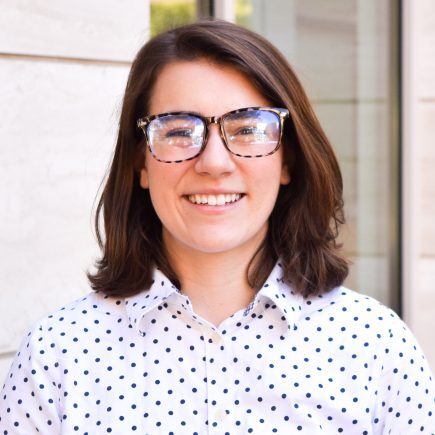Art history students Ivy Griffiths and Emma Belnap excel in their humanities degrees and fellowships.
Ever wondered what it takes to be an undergraduate fellow? Look no further than Ivy Griffiths (Art History ’25) and Emma Belnap (Art History ’24). Though they didn’t initially plan to pursue degrees in the humanities, these art history students embody the mission of the College of Humanities through their academic pursuits and contributions as Humanities Center undergraduate fellows.
Ivy Griffiths

A clear road to graduation didn’t immediately present itself to Ivy Griffiths. Torn between her talent for STEM subjects and her love for art, Griffiths originally considered majoring in industrial design as a compromise. But when she tried out a design course and didn’t love it, she went back to square one—until her major advisor suggested art history, a field that she had no experience in. Fast forward a couple years: Griffiths is now not only an art history major, but a Humanities Center undergraduate fellow and a BYU Museum of Art curatorial fellow.
Describing the beginning of her art history journey, Griffiths says, “I took the medieval art class, and that's when I really got interested . . . I enjoy learning about religious art in particular. It's like a new language, the way that they expound on different principles or ideas through different iconography [use of visual images or symbols to represent complex themes].” She has continued this study of medieval art outside of the classroom, receiving a HUM Grant to write a research paper on a 10th-century Byzantine depiction of the Crucifixion. She specifically studied the portrayal of light and shadow in the piece and how that gives insight into theological principles of the time.
Thanks to her noticeable hard work and dedication to the humanities, Griffiths received a nomination from one of her professors to become a Humanities Center undergraduate fellow. She fulfills several responsibilities in that role, including planning and preparing large College-sponsored events. Recently, she helped choose six speakers for the HUM Grant Symposium, an event in which HUM Grant recipients have a chance to present their research.
Griffiths values the skills that she’s obtaining from her humanities degree and fellowship. She says, “The humanities teach us to be good communicators. That’s something that I know the workforce is looking for. They really need people who have good interpersonal skills and who are good at research.”
Emma Belnap

Emma Belnap came to college with the intention of pursuing a medical degree, but Chemistry 105 changed her mind about that. Like Griffiths, she switched plans and chose to pursue an art history major that led to her undergraduate fellowship. Belnap says, “I’ve always loved looking at paintings and trying to find out what the artist was trying to say and what was motivating the creation of that art piece at that time. And taking [art history] classes just helped me realize that there are careers to be had. And not only that, but there is so much joy that I find in this major.”
During her time at BYU, Belnap has developed a particular interest in 18th- and 19th-century European art with an emphasis on gender and race. She believes that it’s important for everyone to see themselves in history, and she hopes that her research will shine a light on historically underrepresented people in art. She also believes that studying artistic portrayals of minority groups, such as women and people of color, can help discern what the artists were thinking about members of those groups at the time. Belnap says, “The portrait that immediately comes to mind is Benoist’s Portrait of Madeleine . . . looking at this beautiful woman of color who’s been portrayed, and thinking about how she’s being represented not as necessarily a victim to her circumstances, but as this figure of victory.”

Belnap’s passion and direction led to her nomination as a Humanities Center undergraduate fellow. Fulfilling one of the duties of the position, she recently authored a Humanities Center blog post about the importance of the digital humanities. In that post, she claims that the continued existence of the humanities discipline rests on the public-facing element of digital humanities. Belnap has seen the importance of digital humanities through her work as a research assistant for the Book of Mormon Art Catalog. Her team spreads awareness about their project through online methods such as digital articles, social media, and upcoming interviews. These efforts help the public understand and participate in the humanities in an accessible way.
Beyond Graduation
As Humanities Center undergraduate fellows, Griffiths and Belnap each receive one year of free tuition to help them along their journeys to graduation. In the future, Griffiths hopes to attend grad school abroad and pursue work as a museum curator. Belnap hopes to obtain her PhD and go into academia as a professor. Through their many achievements, these art history majors represent the plethora of academic and personal opportunities that await students in the College of Humanities.
Learn more about the Humanities Center fellows here.